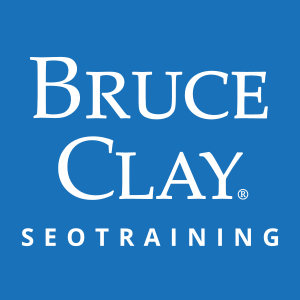Dive into Our Online SEO Training Curriculum

Our online SEO training curriculum is more than just a course — it’s a robust, intensive program that helps you learn SEO techniques to improve your search engine rankings. Below are descriptions of the modules from our curriculum. Each module is designed to help you learn and adapt to the ever-evolving landscape of SEO.
Module 1: The Importance of SEO
Difficulty Level: Beginner
Ever wonder why some sites have more web traffic than others? Even if you’re familiar with SEO, the answer to this question may surprise you. You’ll want to start with this module if you’re new to this online SEO training curriculum.
How well you rank on a SERP depends mostly on your understanding of search principles. You can use SEO analysis to understand how and why your competitors are outranking you. Armed with this information, you’ll be equipped to develop more effective marketing campaigns.
Bottom line: If you want to outrank your competitors, you need to understand how SEO works. This module will serve as the foundation for your digital marketing strategy.
In this module, we:
- Define SEO
- Offer basic information about SEO
Module 2: SEO Concepts
Difficulty Level: Beginner
Showing up on the first page of the search results increases your perceived authority and trustworthiness — two facets of EEAT that Google values. Your content needs this visibility to move the needle in your business. If you don’t apply solid SEO strategies, even the most informative and compelling content can sink to the bottom of the search engine results pages (SERPs).
Avoid falling into digital obscurity with the information covered in this module. The SEO Concepts module will teach you more about analyzing your website’s current SEO status, implementing keyword research, and adjusting your website’s structure and content according to the latest SEO guidelines
In this module, we:
- Cover search engine ranking factors
- Define concepts such as YMYL, E-E-A-T, and others
- Discuss least imperfect and ranking curves
- Teach you the importance of keyword research
- Go over query intent and what it means for your website
Module 3: Meet the Search Engines
Difficulty Level: Beginner
Search engines act as gatekeepers, determining which websites are placed prominently on search engine results pages (SERPs). Hundreds of factors influence ranking, including relevance, domain authority, and user experience. On top of that, search engines frequently update their algorithms. So, it’s critical to learn how to employ a continuous learning approach to stay ahead of each update.
In this portion of our online SEO class, Bruce Clay reveals the mechanics behind search engines and their profound impact on a website’s visibility.
In this module, we:
- Review how search engines work
- Uncover what factors you need to pay attention to in order to rank
Module 4: Website Anatomy
Difficulty Level: Intermediate
Making a website SEO-friendly is about more than just aesthetics. From URL structuring to meta tags, every detail of your website plays a pivotal role in its rankability. With a solid understanding of the granular aspects of website architecture, you’ll be able to create an intuitive layout that users and search engines can easily navigate and index.
In this module, we:
- Study on-page tags
- Learn the ins and outs of HTML components and how to optimize images, links, and body text
- Cover must-know information about the images, links, and body text on your website
Module 5: Search Now and in the Future
Difficulty Level: Intermediate
What does your target audience struggle with? What do they search for? If you haven’t already, you’ll need to consider these questions. At its core, SEO is all about understanding the needs and behaviors of your target audience and tailoring your content to meet those needs.
By understanding your audience’s demographic details, such as age, occupation, interests, and problems they aim to solve, you can craft content that directly addresses their pain points. In this portion of our online SEO training curriculum, you’ll learn proven ways to engage your target audience, including content, video, and social media.
In this module, we:
- Review the importance of personas as it relates to content and usability
- Cover important facets of a user’s journey such as video, voice search, social media, and featured snippets
Module 6: Content for SEO
Difficulty Level: Intermediate
Want all eyes on your website content? Writing a few — or even many — high-quality pages isn’t enough. You need to ensure that your target audience sees your high-quality content. When it comes to SEO, content serves as the medium through which search engines interpret your site’s value and context. If a search engine deems your content appropriate for your target audience, they’ll stay on your website for longer. This increases your website’s dwell time — a factor search engines also consider when ranking your content.
To show search engines that you have content worthy of high rankings, you’ll need to produce valuable content that uses the right keyword phrases and keyword placement. Here, we show you how.
In this module, we:
- Teach you how to select the right keywords for your target audience
- Show you how to outshine your competitors by conducting a content gap analysis
- Review tips for writing cleanly and efficiently
Module 7: Local Search
Difficulty: Advanced
People increasingly rely on mobile devices to search for nearby businesses, services, or restaurants. With these advanced SEO local search techniques, you can put your goods and/or services on full display in front of potential customers. Many users include location-based keywords in their search queries, such as “near me,” making local SEO strategies critical for capturing this target audience.
Local SEO significantly enhances discoverability for businesses targeting users who seek products and services within a specific geographic area. This focus on location-based searching allows smaller, local businesses to compete with larger national companies by allowing them to target their audience more precisely. Local SEO involves optimizing your website and online presence so you appear in local search listings like map packs or localized organic results.
Individuals who perform local searches are more inclined to make a purchase than those conducting broader searches. Optimizing for local search can lead directly to more customers and increased sales or service bookings.
In this module, we:
- Teach you how to rank in local searches
- Show you why local search matters
Module 8: Linking Strategies
Difficulty Level: Advanced
Linking strategies are not merely about connecting web pages; they play a pivotal role in optimizing your site for search engines and improving the user experience.
Linking can be internal (connecting different pages on your website) or external (involving links from other websites to yours). Both types of linking play a critical role in SEO. Internal links play a key role in informing search engines of the hierarchical structure of your website. This can help search engines quickly index your website, improving your ability to be found in SERPs through organic rankings. External links, on the other hand, contribute more to your site’s credibility and authority.
In this portion of our online SEO training curriculum, you’ll learn how to garner high-quality backlinks and balance your internal linking structure.
In this module, we:
- Show you white-hat link acquisition methods
- Review the right way to clean up links
- Teach you how to effectively manage your reputation via effective linking techniques
Module 9: Siloing Concepts
Difficulty Level: Advanced
Developed by Bruce Clay, siloing is a technique that makes it easier for users and search engines to understand a site’s structure. It involves organizing a website so that each cluster, or “silo,” is themed around a core topic and related subtopics. Siloing takes a cluttered mess of pages, posts, and media and unifies the content based on themes, making it much easier for search engines to evaluate and index a website.
Many website owners produce content that would be useful to their target audience — if only that target audience could find it. A disorganized site can confuse both users and search engines, resulting in poor traffic and engagement rates. This portion of our online SEO training curriculum covers the art of siloing to improve overall site clarity and performance.
In this module, we:
- Teach you what siloing is
- Show you how to silo content
- Review the hierarchy of siloing
- Elaborate on siloing procedures
Module 10: Technical SEO
Difficulty Level: Advanced
Technical SEO, the nitty gritty component of search engine optimization, involves optimizing the infrastructure of your website to improve its visibility and ranking on search engines. It encompasses a range of practices that make it easier for search engines to crawl, interpret, and index your website’s content. From crawler accessibility to URL structure, this module helps ensure your website is fast, reliable, and user-friendly.
With a structured approach and the right tools, you can implement these technical SEO optimizations to enhance your search engine performance.
In this module, we:
- Cover technical SEO guidelines
- Learn about crawl budget, redirects, and more
Module 11: AI Search Signals
Difficulty Level: Advanced
AI has revolutionized search, so this module will cover what AI is looking for on your site. This module will look into some of the important elements that AI will be looking at. It is essential to pay attention to which ranking factors matter the most as AI continues to evolve. This module will provide actionable strategies, from improving tone consistency to enhancing topical authority. Content optimization isn’t about tricking search engines; it’s about building trustworthy, human-centered experiences that AI recognizes and rewards.
In this module, we:
- Review optimizing on-page elements and content to better suit AI
- Show you how to improve technical SEO items important for AI
- Discuss Content Strategies that improve AI and user engagement effectively
Learn Actionable Steps to Boost Your Revenue with Our Online SEO Training Curriculum
Mastering SEO is a marathon requiring you to remain informed on the latest practices. Ready to start winning?
Contact us for more info on how to enroll!
FAQ: How can the Bruce Clay Inc. online SEO training curriculum help me master SEO techniques and boost my website’s rankings?
The Bruce Clay Inc. online SEO training curriculum is meticulously designed to help you understand and excel in search engine optimization through a comprehensive, systematic approach. This curriculum provides a solid foundation in SEO principles, offering essential tools and strategies necessary for users of all levels to succeed in the competitive digital landscape.
Our curriculum provides in-depth details on how to:
- Leverage basic SEO knowledge to improve your rankings
- Recognize parts of your website that are essential to SEO
- Implement technical SEO for optimal website functionality
- Conduct quality keyword research to attract your target audience to your website
- Manage your digital reputation by using linking strategies
- Use Bruce Clay’s own siloing technique to assist search engines in crawling and ranking your content
- Harness local SEO to attract your target audience in specific geographic areas
- Create content that resonates with users and boosts rankings
- Appeal to the growing popularity of mobile users
- Identify key present and future trends in SEO
- Determine which search engines you will target and why
Expert guidance from an online SEO training curriculum can significantly simplify the learning process, enabling you to master SEO techniques and boost your website’s rankings.
